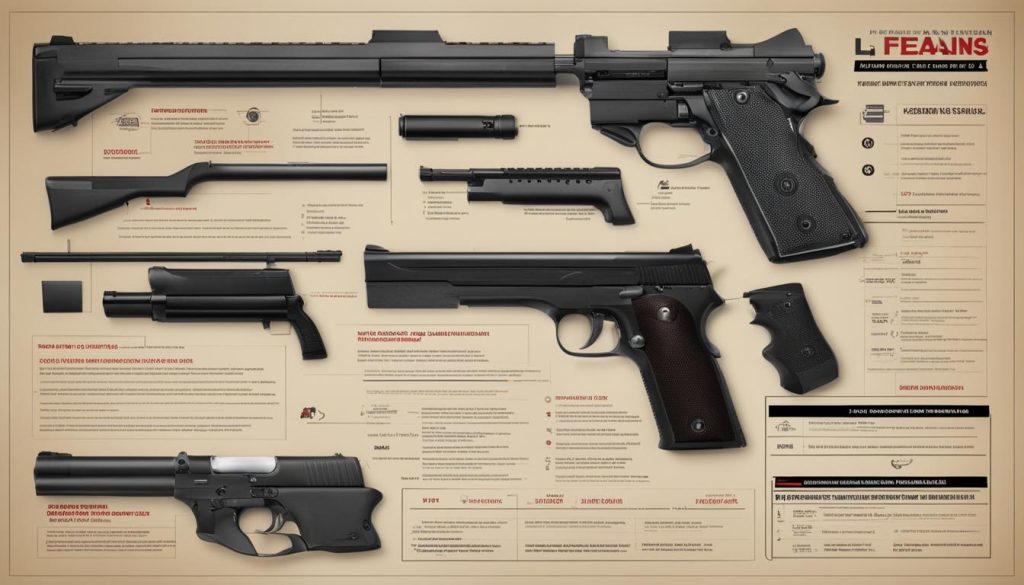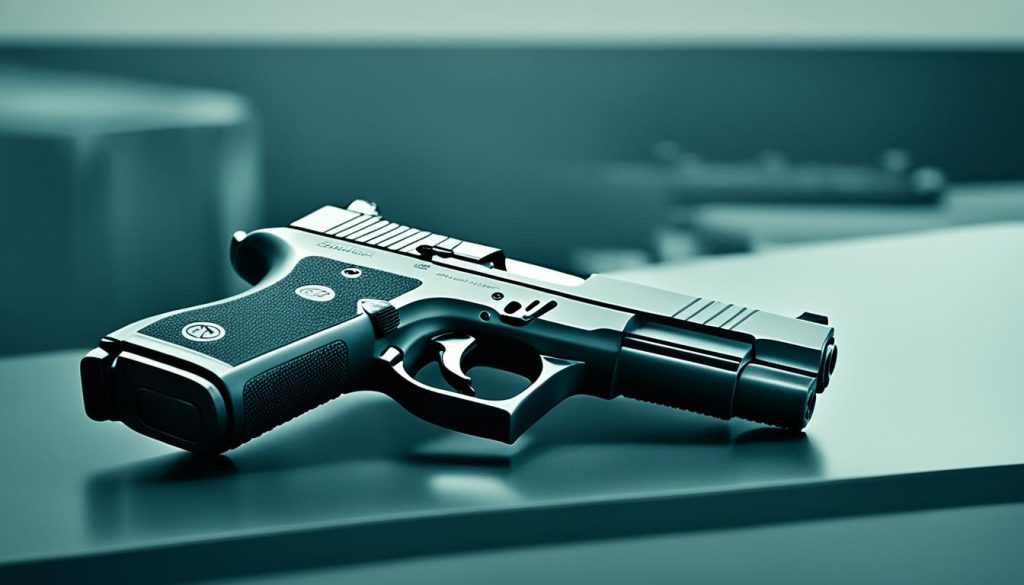As a firearms enthusiast in Canada, it is essential to have a thorough understanding of the country’s regulations and gun laws. The possession, use, and acquisition of firearms are governed by the Firearms Act and the Criminal Code, ensuring public safety and responsible ownership.
Compliance with these regulations is crucial to avoid legal issues and protect the well-being of yourself and others. In this comprehensive guide, I will walk you through important information about non-restricted firearms in Canada, including licensing, categories, storage, transportation, offences, registration, and disposal.
Key Takeaways:
- Understanding Canadian firearm laws is crucial for gun owners to ensure compliance and avoid legal trouble.
- Obtaining a Possession and Acquisition License (PAL) and completing the Canadian Firearms Safety Course is necessary for legal firearm ownership in Canada.
- Non-restricted firearms are the most common type used for hunting and have fewer restrictions compared to restricted or prohibited firearms.
- Safely storing and transporting firearms in accordance with regulations is vital to prevent unauthorized access and maintain public safety.
- Criminal Code outlines firearm offences and penalties, emphasizing the severity of illegal possession, use, or storage of firearms.
Keep reading to discover more about non-restricted firearms in Canada and navigate the regulations with confidence.
Understanding Firearms Licensing in Canada
Obtaining the necessary licenses and certifications is a crucial step for individuals looking to possess and acquire firearms in Canada. In order to legally own firearms in the country, one must obtain a Possession and Acquisition License (PAL) issued by the Royal Canadian Mounted Police (RCMP).
The process of obtaining a PAL involves several important steps:
- Background Check: Applicants are required to undergo a thorough background check to ensure they meet the eligibility criteria set by the RCMP. This check includes criminal record checks, mental health checks, and checks on previous incidents involving violence or domestic abuse.
- Canadian Firearms Safety Course (CFSC): As part of the licensing process, applicants must successfully complete the Canadian Firearms Safety Course. This course provides essential knowledge and training on firearm safety, including handling, storage, and transportation. It covers both non-restricted and restricted firearms, ensuring individuals are aware of the responsibilities that come with firearm ownership.
- Application Submission: Once the background check is complete and the CFSC is successfully completed, applicants can submit their PAL application to the RCMP. The application must include all necessary documents and fees.
- License Renewal: The PAL is valid for a period of five years. It is the responsibility of the license holder to ensure timely renewal to maintain legal firearm ownership.
By obtaining a PAL, individuals demonstrate their commitment to responsible firearm ownership and the safety of themselves and others. It is important to note that the possession and acquisition of firearms without a valid license is illegal and can result in severe penalties.
For anyone considering firearm ownership in Canada, it is vital to understand and adhere to the licensing requirements and regulations. Obtaining the necessary licenses and completing the Canadian Firearms Safety Course are essential steps to ensure compliance with the law and promote safe firearm handling and ownership.

| Key Points | Benefits |
|---|---|
| Obtain a Possession and Acquisition License (PAL) | – Legalizes firearm ownership – Gives access to a wider range of firearms – Demonstrates commitment to responsible ownership |
| Undergo background checks | – Ensures eligibility criteria are met – Promotes public safety – Prevents firearm possession by individuals with violent or criminal histories |
| Complete Canadian Firearms Safety Course (CFSC) | – Enhances knowledge and understanding of firearm safety – Covers handling, storage, and transportation guidelines – Fosters responsible firearm ownership |
| Timely renewal of PAL | – Ensures continuous legal firearm ownership – Demonstrates commitment to ongoing compliance – Promotes responsible firearm management |
Categories of Firearms in Canada
When it comes to firearms in Canada, it is crucial to understand the different categories they are classified into. This categorization plays a significant role in determining the regulations and restrictions surrounding their possession and use.
Firearms in Canada are divided into three categories: non-restricted, restricted, and prohibited.
Non-Restricted Firearms
Non-restricted firearms are the most commonly owned and widely available type of firearms in Canada. These firearms include most rifles and shotguns that are primarily used for hunting and sport shooting. Individuals who are properly licensed can legally purchase non-restricted firearms from licensed retailers across the country. These firearms do not have any additional storage or transportation requirements beyond the general regulations.
Restricted Firearms

Restricted firearms are subject to additional regulations and restrictions compared to non-restricted firearms. They include certain types of handguns, semi-automatic rifles and shotguns, and firearms with specific design characteristics. These firearms can only be legally owned and possessed by individuals who hold a valid Possession and Acquisition License (PAL) endorsed for restricted firearms. The storage and transportation requirements for restricted firearms are more stringent than those for non-restricted firearms. They must be stored securely and transported in accordance with specific regulations.
Prohibited Firearms
Prohibited firearms are the most heavily regulated and restricted category of firearms in Canada. They include fully automatic firearms, converted automatic firearms, and firearms with a short barrel length. Certain types of handguns are also classified as prohibited firearms. It is generally illegal to possess, acquire, or transfer prohibited firearms unless you have received special authorization from the Chief Firearms Officer. Prohibited firearms that were legally owned before specific changes in the law may be grandfathered in, but their use is highly regulated. These firearms must be stored in a secure manner and cannot be transported without written permission from the Chief Firearms Officer.
Understanding the categories of firearms in Canada is essential for anyone who wishes to possess or acquire firearms legally. It ensures that you are aware of the necessary licensing, storage, and transportation requirements for each category. By adhering to the regulations, you can enjoy firearm ownership within the legal boundaries set forth by the Canadian government.
Storage and Transportation of Firearms
When it comes to firearm ownership in Canada, responsible storage and transportation are vital aspects that should not be overlooked. By adhering to proper firearm storage and transportation regulations, we can ensure public safety and prevent unauthorized access to firearms.
First and foremost, it’s important to note that the specific regulations for storage and transportation may vary depending on the category of the firearm. Non-restricted firearms, such as most rifles and shotguns used for hunting, have specific requirements that owners must adhere to.
Non-restricted firearms must be stored unloaded and in a secure location, such as a locked cabinet or safe. This helps prevent accidental discharge and unauthorized access. Additionally, ammunition should be stored separately in a locked container.
On the other hand, restricted and prohibited firearms have additional storage requirements. They must be stored unloaded, in a locked container made specifically for firearms, and equipped with a locking device. This ensures an extra layer of security and minimizes the risk of theft or misuse.
When it comes to transporting firearms, whether it’s for hunting or competition purposes, it’s essential to comply with the regulations set by the authorities. Here are a few key guidelines to keep in mind:
- Firearms must be transported unloaded and in a secure manner, such as a locked case or container.
- The ammunition should be stored separately from the firearm during transportation.
- Always ensure that the firearm is not easily accessible to the driver or passengers.
- If transporting firearms by vehicle, it’s crucial to comply with any specific regulations in your province or territory.
Remember, failure to follow these regulations can lead to legal consequences, including fines and imprisonment. By understanding and following the guidelines for firearm storage and transportation, we can contribute to a safer society.
| Firearm Type | Storage Requirements | Transportation Guidelines |
|---|---|---|
| Non-Restricted | Unloaded, stored in a secure location, ammunition stored separately | Unloaded, in a secure manner, ammunition separate during transportation |
| Restricted/Prohibited | Unloaded, stored in a locked container with a locking device, ammunition stored separately | Unloaded, in a locked case or container, ammunition separate during transportation |
Firearm Offences and Penalties
The Criminal Code in Canada outlines various firearm offences that carry severe legal consequences. It is crucial to have a clear understanding of Canadian firearm laws and regulations to avoid getting involved in illegal activities related to firearms. Some of the common firearm offences include unauthorized use, possession, or storage of firearms.
Illegal possession of firearms is a serious offense under Canadian law. It is essential to comply with the regulations to prevent potential legal trouble. The penalties for firearm offences can vary depending on the severity of the offense and the circumstances surrounding it.
Canada has strict laws and penalties related to firearms due to the country’s commitment to public safety and the prevention of gun violence. Engaging in illegal activities involving firearms can result in severe consequences, including hefty fines and imprisonment.
It is important to note that ignorance of the law is not a valid defense if charged with a firearm offence. As a responsible gun owner, it is your duty to stay informed about the Canadian firearm laws and comply with them at all times.
By understanding and respecting these laws, you contribute to a safer society and help prevent the misuse of firearms. If you have any doubts or questions about specific firearm laws, it is advisable to consult with legal professionals or authorities who specialize in firearms legislation.
Examples of Firearm Offences and Penalties:
| Firearm Offence | Penalties |
|---|---|
| Unauthorized Possession of a Firearm | Up to 10 years imprisonment |
| Illegal Sale of Firearms | Up to 14 years imprisonment |
| Use of a Firearm in the Commission of a Crime | Minimum 4 years imprisonment |
| Failure to Comply with Storage Regulations | Fines and imprisonment varying by severity |
Firearm Registration and Disposal
In Canada, certain firearms, such as restricted and prohibited firearms, must be registered with the Canadian Firearms Program. To register a firearm, you have the option to complete the process online or by mailing an application form to the Royal Canadian Mounted Police (RCMP).
If you are looking to dispose of a firearm, it is important to follow the proper procedures and adhere to legal requirements. There are several ways to dispose of firearms in Canada. One option is to sell the firearm to licensed individuals or businesses. Another option is to have the firearm deactivated, rendering it permanently inoperable.
In some cases, you may also choose to turn in the firearm to the police. It is crucial to ensure that the firearm is properly deregistered before disposing of it. By following the appropriate procedures for registering and disposing of firearms, you can contribute to the safety and compliance of Canada’s gun laws.